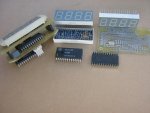Hi all 
Does anyone know of any I2C chips that can be used to control two or three 7-segment LED displays?
I know of the more normal method, but I am thinking of an add-on later, which would use the I2C bus, and the LED modules would be on a front panel, not part of the main circuit-board.
Will look at anything, but with the range of chips you can get to do things these days, not sure exactly where to start looking - hoping someone here might have already done this, and can point me to an approriate I2C slave chip.
I would need any controller chip to:
- Allow me to set the slave address
- Be able to drive at least two or more 7-segment displays
Any pointers?
EDIT: I will be using a 20X2 chip as the controller/I2C master device.
Does anyone know of any I2C chips that can be used to control two or three 7-segment LED displays?
I know of the more normal method, but I am thinking of an add-on later, which would use the I2C bus, and the LED modules would be on a front panel, not part of the main circuit-board.
Will look at anything, but with the range of chips you can get to do things these days, not sure exactly where to start looking - hoping someone here might have already done this, and can point me to an approriate I2C slave chip.
I would need any controller chip to:
- Allow me to set the slave address
- Be able to drive at least two or more 7-segment displays
Any pointers?
EDIT: I will be using a 20X2 chip as the controller/I2C master device.

